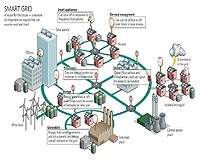 |
Bonn, Germany (SPX) May 10, 2010 The hairs on the surface of water ferns could allow ships to have a 10 per cent decrease in fuel consumption. The plant has the rare ability to put on a gauzy skirt of air under water. Researchers at the University of Bonn, Rostock and Karlsruhe now show in the journal Advanced Materials how the fern does this. Their results can possibly be used for the construction of new kinds of hulls with reduced friction. The water fern salvinia molesta is exremely hydrophobic. If it is submerged and subsequently pulled out the liquid immediately drips off it. After that it is completely dry again. Or to be more precise: it was never really wet. For the fern surrounds itself by a flimsy skirt of air. This layer prevents the plant from coming into contact with liquid. And that even with a dive lasting weeks. Materials researchers call this behaviour 'superhydrophobic'. This property is of interest for many applications such as rapidly drying swimsuits or simply for fuel-efficient ships. Meanwhile, it is possible to construct superhydrophobic surfaces modelled on nature. However, these 'replicas' have a disadvantage: the layer that forms on them is too unstable. In moving water it disappears after several hours at the latest. The researchers from Bonn, Rostock und Karlsruhe have now deciphered the trick the water fern uses to pin down its airy skirt. It has been known for some years now that on the surface of its leaves there are tiny whisk-like hairs. These are hydrophobic. They keep water in the surroundings at a distance.
Water is 'stapled in place' Professor Barthlott is head of the Nees Institute of Biodiversity of Plants in Bonn. There the experiments began which are continued today in conjunction with the Chair of Fluid Dynamics at the University of Rostock and the Institute of Applied Physics at the University of Karlsruhe. 'After the solving of the self-cleansing of the lotus leaf twenty years ago, the discovery of the salvinia effect is one of the most important new discoveries in bionics,' Professor Thomas Schimmel from the University of Karlsruhe says.
Fuel saved world wide: one per cent 'Probably one per cent of the fuel consumption worldwide could be saved this way, is Professor Barthlott's prognosis. 'Surfaces modelled on the water fern could revolutionise shipbuilding,' Professor Dr. Alfred Leder from the University of Rostock concurs. Lotus and the water fern salvinia are only two of maybe twenty million species populating our planet. They all have their secrets, and Bonn, Rostock and Karlsruhe are working on unlocking these.
Share This Article With Planet Earth
Related Links University of Bonn Powering The World in the 21st Century at Energy-Daily.com
 Wideband Powerline Communications AMI For Future Proof Smart Grid Apps
Wideband Powerline Communications AMI For Future Proof Smart Grid AppsValencia, Spain (SPX) May 06, 2010 DS2 has announced the availability, for the global utility market, of DS2's Wideband PLC Advanced Metering Infrastructure (AMI) silicon and firmware package and its AMI Evaluation Kit. The solution combines DS2's UPA wideband powerline communications hardware operating on the 2-12 MHz range with a software package field-tested and optimized for AMI. It includes the DR200 Head End Reference ... read more |
|
| The content herein, unless otherwise known to be public domain, are Copyright 1995-2010 - SpaceDaily. AFP and UPI Wire Stories are copyright Agence France-Presse and United Press International. ESA Portal Reports are copyright European Space Agency. All NASA sourced material is public domain. Additional copyrights may apply in whole or part to other bona fide parties. Advertising does not imply endorsement,agreement or approval of any opinions, statements or information provided by SpaceDaily on any Web page published or hosted by SpaceDaily. Privacy Statement |